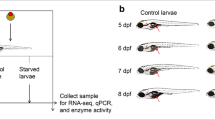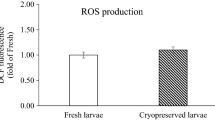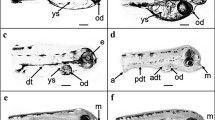Abstract
Gut microbiota plays a fundamental role in maintaining host’s health by controlling a wide range of physiological processes. Administration of probiotics and manipulation of photoperiod have been suggested as modulators of microbial composition and are currently undergoing an extensive research in aquaculture as a way to improve health and quality of harvested fish. However, our understanding regarding their effects on physiological processes is still limited. In the present study we investigated whether manipulation of photoperiod and/or probiotic administration was able to alter microbial composition in zebrafish larvae at hatching stage. Our findings show that probiotic does not elicit effects while photoperiod manipulation has a significant impact on microbiota composition. Moreover, we successfully predicted lipid biosynthesis and apoptosis to be modulated by microbial communities undergoing continuous darkness. Interestingly, expression levels of caspase 3 gene (casp3) and lipid-related genes (hnf4a, npc1l1, pparγ, srebf1, agpat4 and fitm2) were found to be significantly overexpressed in dark-exposed larvae, suggesting an increase in the occurrence of apoptotic processes and a lipid metabolism impairment, respectively (p < 0.05). Our results provide the evidence that microbial communities in zebrafish at early life stages are not modulated by a short administration of probiotics and highlight the significant effect that dark photoperiod elicits on zebrafish microbiota and potentially on health.






Similar content being viewed by others
References
Sender R, Fuchs S, Milo R (2016) Revised estimates for the number of human and bacteria cells in the body. PLoS Biol 14:e1002533. https://doi.org/10.1371/journal.pbio.1002533
Selber-Hnatiw S, Rukundo B, Ahmadi M, Akoubi H, Al-Bizri H, Aliu AF et al (2017) Human gut microbiota: toward an ecology of disease. Front Microbiol 8:1265. https://doi.org/10.3389/fmicb.2017.01265
Thursby E, Juge N (2017) Introduction to the human gut microbiota. Biochem J 474:1823–1836. https://doi.org/10.1042/BCJ20160510
Li X, Ringø E, Hoseinifar SH, Lauzon HL, Birkbeck H, Yang D (2018) The adherence and colonization of microorganisms in fish gastrointestinal tract. Rev Aquac. https://doi.org/10.1111/raq.12248
Torres-Fuentes C, Schellekens H, Dinan TG, Cryan JF (2017) The microbiota–gut–brain axis in obesity. Lancet Gastroenterol Hepatol 2:747–756. https://doi.org/10.1016/S2468-1253(17)301474
Quigley EMM (2017) Microbiota-brain-gut axis and neurodegenerative diseases. Curr Neurol Neurosci Rep 17:94. https://doi.org/10.1007/s11910-017-0802-6
Yang T, Richards EM, Pepine CJ, Raizada MK (2018) The gut microbiota and the brain–gut–kidney axis in hypertension and chronic kidney disease. Nat Rev Nephrol 14:442–456. https://doi.org/10.1038/s41581-018-0018-2
Budden KF, Gellatly SL, Wood DLA, Cooper MA, Morrison M, Hugenholtz P et al (2017) Emerging pathogenic links between microbiota and the gut–lung axis. Nat Rev Microbiol 15:55–63. https://doi.org/10.1038/nrmicro.2016.142
Schroeder BO, Bäckhed F (2016) Signals from the gut microbiota to distant organs in physiology and disease. Nat Med 22:1079–1089. https://doi.org/10.1038/nm.4185
Adamovsky O, Buerger AN, Wormington AM, Ector N, Griffitt RJ, Bisesi JH et al (2018) The gut microbiome and aquatic toxicology: an emerging concept for environmental health. Environ Toxicol Chem 37:2758–2775. https://doi.org/10.1002/etc.4249
Liang X, Bushman FD, FitzGerald GA (2014) Time in motion: the molecular clock meets the microbiome. Cell. 159:469–470. https://doi.org/10.1016/j.cell.2014.10.020
Voigt RM, Forsyth CB, Green SJ, Mutlu E, Engen P, Vitaterna MH et al (2014) Circadian disorganization alters intestinal microbiota. PLoS One 9:e97500. https://doi.org/10.1371/journal.pone.0097500
Maywood ES (2018) Synchronization and maintenance of circadian timing in the mammalian clockwork. Eur J Neurosci. https://doi.org/10.1111/ejn.14279
Pilorz V, Helfrich-Förster C, Oster H (2018) The role of the circadian clock system in physiology. Pflugers Arch - Eur J Physiol 470:227–239. https://doi.org/10.1007/s00424-017-2103-y
Idda ML, Bertolucci C, Vallone D, Gothilf Y, Sánchez-Vázquez FJ, Foulkes NS (2012) Circadian clocks: lessons from fish. Progress in brain research, pp 41–57. https://doi.org/10.1016/B978-0-444-59427-3.00003-4
Thaiss CA, Zeevi D, Levy M, Zilberman-Schapira G, Suez J, Tengeler AC et al (2014) Transkingdom control of microbiota diurnal oscillations promotes metabolic homeostasis. Cell. 159:514–529. https://doi.org/10.1016/j.cell.2014.09.048
Deaver JA, Eum SY, Toborek M (2018) Circadian disruption changes gut microbiome taxa and functional gene composition. Front Microbiol 9:737. https://doi.org/10.3389/fmicb.2018.00737
Azad MAK, Sarker M, Li T, Yin J (2018) Probiotic species in the modulation of gut microbiota: an overview. Biomed Res Int 2018:1–8. https://doi.org/10.1155/2018/9478630
Merrifield DL, Dimitroglou A, Foey A, Davies SJ, Baker RTM, Bøgwald J et al (2010) The current status and future focus of probiotic and prebiotic applications for salmonids. Aquaculture. 302:1–18. https://doi.org/10.1016/J.AQUACULTURE.2010.02.007
Hoseinifar SH, Sun Y-Z, Wang A, Zhou Z (2018) Probiotics as means of diseases control in aquaculture, a review of current knowledge and future perspectives. Front Microbiol 9:2429. https://doi.org/10.3389/fmicb.2018.02429
Zorriehzahra MJ, Delshad ST, Adel M, Tiwari R, Karthik K, Dhama K et al (2016) Probiotics as beneficial microbes in aquaculture: an update on their multiple modes of action: a review. Vet Q 36:228–241. https://doi.org/10.1080/01652176.2016.1172132
Ringø E, Hoseinifar SH, Ghosh K, Van DH, Beck BR, Song SK (2018) Lactic acid bacteria in finfish—an update. Front Microbiol 9:1818. https://doi.org/10.3389/fmicb.2018.01818
Liu Z, Liu W, Ran C, Hu J, Zhou Z (2016) Abrupt suspension of probiotics administration may increase host pathogen susceptibility by inducing gut dysbiosis. Sci Rep 6:23214. https://doi.org/10.1038/srep23214
Fiszbein A, Cánepa M, Vázquez GR, Maggese C, Pandolfi M (2010) Photoperiodic modulation of reproductive physiology and behaviour in the cichlid fish Cichlasoma dimerus. Physiol Behav 99:425–432. https://doi.org/10.1016/j.physbeh.2009.11.017
Oliveira C, Vera LM, López-Olmeda JF, Guzmán JM, Mañanós E, Ramos J et al (2009) Monthly day/night changes and seasonal daily rhythms of sexual steroids in Senegal sole (Solea senegalensis) under natural fluctuating or controlled environmental conditions. Comp Biochem Physiol Part A Mol Integr Physiol 152:168–175. https://doi.org/10.1016/j.cbpa.2008.09.012
Oliveira CCV, Aparício R, Blanco-Vives B, Chereguini O, Martín I, Javier Sánchez-Vazquez F (2013) Endocrine (plasma cortisol and glucose) and behavioral (locomotor and self-feeding activity) circadian rhythms in Senegalese sole (Solea senegalensis Kaup 1858) exposed to light/dark cycles or constant light. Fish Physiol Biochem 39:479–487. https://doi.org/10.1007/s10695-012-9713-2
Falcinelli S, Picchietti S, Rodiles A, Cossignani L, Merrifield DL, Taddei AR et al (2015) Lactobacillus rhamnosus lowers zebrafish lipid content by changing gut microbiota and host transcription of genes involved in lipid metabolism. Sci Rep 5:9336. https://doi.org/10.1038/srep09336
Falcinelli S, Rodiles A, Hatef A, Picchietti S, Cossignani L, Merrifield DL et al (2017) Dietary lipid content reorganizes gut microbiota and probiotic L. rhamnosus attenuates obesity and enhances catabolic hormonal milieu in zebrafish. Sci Rep 7:5512–5515. https://doi.org/10.1038/s41598-017-05147-w
Martin M (2011) Cutadapt removes adapter sequences from high-throughput sequencing reads. EMBnet.journal 17:10. https://doi.org/10.14806/ej.17.1.200
Del Fabbro C, Scalabrin S, Morgante M, Giorgi FM (2013) An extensive evaluation of read trimming effects on Illumina NGS data analysis. PLoS One 8:e85024. https://doi.org/10.1371/journal.pone.0085024
Weiss S, Xu ZZ, Peddada S, Amir A, Bittinger K, Gonzalez A et al (2017) Normalization and microbial differential abundance strategies depend upon data characteristics. Microbiome. 5:27. https://doi.org/10.1186/s40168-017-0237-y
McMurdie PJ, Holmes S (2013) phyloseq: an R package for reproducible interactive analysis and graphics of microbiome census data. PLoS One 8:e61217. https://doi.org/10.1371/journal.pone.0061217
Oksanen J, Blanchet FG, Friendly M, Kindt R, Legendre P, McGlinn D et al (2018) Vegan: community ecology package. https://cran.r-project.org/package=vegan
Love MI, Huber W, Anders S (2014) Moderated estimation of fold change and dispersion for RNA-seq data with DESeq2. Genome Biol 15:550. https://doi.org/10.1186/s13059-014-0550-8
McMurdie PJ, Holmes S (2014) Waste not, want not: why rarefying microbiome data is inadmissible. PLoS Comput Biol 10:e1003531. https://doi.org/10.1371/journal.pcbi.1003531
Langille MGI, Zaneveld J, Caporaso JG, McDonald D, Knights D, Reyes JA et al (2013) Predictive functional profiling of microbial communities using 16S rRNA marker gene sequences. Nat Biotechnol 31:814–821. https://doi.org/10.1038/nbt.2676
Parks DH, Tyson GW, Hugenholtz P, Beiko RG (2014) STAMP: statistical analysis of taxonomic and functional profiles. Bioinformatics. 30:3123–3124. https://doi.org/10.1093/bioinformatics/btu494
Pfaffl MW (2001) A new mathematical model for relative quantification in real-time RT-PCR. Nucleic Acids Res 29:e45 http://www.ncbi.nlm.nih.gov/pubmed/11328886. Accessed 19 Jan 2017
Bray JR, Curtis JT (1957) An ordination of the upland forest communities of Southern Wisconsin. Ecol Monogr 27:325–349. https://doi.org/10.2307/1942268
Ng ANY, de Jong-Curtain TA, Mawdsley DJ, White SJ, Shin J, Appel B et al (2005) Formation of the digestive system in zebrafish: III. Intestinal epithelium morphogenesis. Dev Biol 286:114–135. https://doi.org/10.1016/j.ydbio.2005.07.013
Bates JM, Mittge E, Kuhlman J, Baden KN, Cheesman SE, Guillemin K (2006) Distinct signals from the microbiota promote different aspects of zebrafish gut differentiation. Dev Biol 297:374–386. https://doi.org/10.1016/j.ydbio.2006.05.006
Stephens WZ, Burns AR, Stagaman K, Wong S, Rawls JF, Guillemin K et al (2016) The composition of the zebrafish intestinal microbial community varies across development. ISME J 10:644–654. https://doi.org/10.1038/ismej.2015.140
O’Connell CM, Ferone ME (2016) Chlamydia trachomatis genital infections. Microb Cell 3:390–403. https://doi.org/10.15698/mic2016.09.525
Roulis E, Polkinghorne A, Timms P (2013) Chlamydia pneumoniae: modern insights into an ancient pathogen. Trends Microbiol 21:120–128. https://doi.org/10.1016/j.tim.2012.10.009
Carnevali O, Zamponi MC, Sulpizio R, Rollo A, Nardi M, Orpianesi C et al (2004) Administration of probiotic strain to improve sea bream wellness during development. Aquac Int 12(4/5):377–386. https://doi.org/10.1023/B:AQUI.0000042141.85977.bb
Dulski T, Zakęś Z, Ciesielski S (2018) Characterization of the gut microbiota in early life stages of pikeperch Sander lucioperca. J Fish Biol 92:94–104. https://doi.org/10.1111/jfb.13496
Givens C, Ransom B, Bano N, Hollibaugh J (2015) Comparison of the gut microbiomes of 12 bony fish and 3 shark species. Mar Ecol Prog Ser 518:209–223. https://doi.org/10.3354/meps11034
Barberán A, Casamayor E (2010) Global phylogenetic community structure and β-diversity patterns in surface bacterioplankton metacommunities. Aquat Microb Ecol 59:1–10. https://doi.org/10.3354/ame01389
Nikouli E, Meziti A, Antonopoulou E, Mente E, Kormas KA (2018) Gut bacterial communities in geographically distant populations of farmed Sea bream (Sparus aurata) and sea bass (Dicentrarchus labrax). Microorganisms. 6. https://doi.org/10.3390/MICROORGANISMS6030092
Kormas KA, Meziti A, Mente E, Frentzos A (2014) Dietary differences are reflected on the gut prokaryotic community structure of wild and commercially reared sea bream (Sparus aurata). Microbiologyopen. 3:718–728. https://doi.org/10.1002/mbo3.202
Titécat M, Wallet F, Vieillard M-H, Courcol RJ, Loïez C (2014) Ruminococcus gnavus: an unusual pathogen in septic arthritis. Anaerobe. 30:159–160. https://doi.org/10.1016/J.ANAEROBE.2014.10.001
Lahti L, Salonen A, Kekkonen RA, Salojärvi J, Jalanka-Tuovinen J, Palva A et al (2013) Associations between the human intestinal microbiota, Lactobacillus rhamnosus GG and serum lipids indicated by integrated analysis of high-throughput profiling data. PeerJ 1:e32. https://doi.org/10.7717/peerj.32
Ryan MP, Pembroke JT (2018) Brevundimonas spp: emerging global opportunistic pathogens. Virulence. 9:480–493. https://doi.org/10.1080/21505594.2017.1419116
Chen J, Chia N, Kalari KR, Yao JZ, Novotna M, Soldan MMP et al (2016) Multiple sclerosis patients have a distinct gut microbiota compared to healthy controls. Sci Rep 6:28484. https://doi.org/10.1038/srep28484
Lemmer B, Oster H (2018) The role of circadian rhythms in the hypertension of diabetes mellitus and the metabolic syndrome. Curr Hypertens Rep 20:43. https://doi.org/10.1007/s11906-018-0843-5
Crnko S, Cour M, Van Laake LW, Lecour S (2018) Vasculature on the clock: circadian rhythm and vascular dysfunction. Vasc Pharmacol 108:1–7. https://doi.org/10.1016/j.vph.2018.05.003
Homolak J, Mudrovčić M, Vukić B, Toljan K (2018) Circadian rhythm and Alzheimer’s disease. Med Sci 6:52. https://doi.org/10.3390/medsci6030052
Shetty A, Hsu JW, Manka PP, Syn W-K (2018) Role of the circadian clock in the metabolic syndrome and nonalcoholic fatty liver disease. Dig Dis Sci 63:3187–3206. https://doi.org/10.1007/s10620-018-5242-x
Firsov D, Bonny O (2018) Circadian rhythms and the kidney. Nat Rev Nephrol 14:626–635. https://doi.org/10.1038/s41581-018-0048-9
Huang YJ, Charlson ES, Collman RG, Colombini-Hatch S, Martinez FD, Senior RM (2013) The role of the lung microbiome in health and disease. A National Heart, Lung, and Blood Institute workshop report. Am J Respir Crit Care Med 187:1382–1387. https://doi.org/10.1164/rccm.201303-0488WS
Surette MG (2014) The cystic fibrosis lung microbiome. Ann Am Thorac Soc 11(Supplement 1):S61–S65. https://doi.org/10.1513/AnnalsATS.201306-159MG
Kostic AD, Xavier RJ, Gevers D (2014) The microbiome in inflammatory bowel disease: current status and the future ahead. Gastroenterology. 146:1489–1499. https://doi.org/10.1053/j.gastro.2014.02.009
Hartstra AV, Bouter KEC, Bäckhed F, Nieuwdorp M (2015) Insights into the role of the microbiome in obesity and type 2 diabetes. Diabetes Care 38:159–165. https://doi.org/10.2337/dc14-0769
Honma S (2018) The mammalian circadian system: a hierarchical multi-oscillator structure for generating circadian rhythm. J Physiol Sci 68:207–219. https://doi.org/10.1007/s12576-018-05975
Grandin LD, Alloy LB, Abramson LY (2006) The social zeitgeber theory, circadian rhythms, and mood disorders: review and evaluation. Clin Psychol Rev 26:679–694. https://doi.org/10.1016/j.cpr.2006.07.001
Vatine G, Vallone D, Gothilf Y, Foulkes NS (2011) It’s time to swim! Zebrafish and the circadian clock. FEBS Lett 585:1485–1494. https://doi.org/10.1016/J.FEBSLET.2011.04.007
Di Rosa V, Frigato E, López-Olmeda JF, Sánchez-Vázquez FJ, Bertolucci C (2015) The light wavelength affects the ontogeny of clock gene expression and activity rhythms in zebrafish larvae. PLoS One 10:e0132235. https://doi.org/10.1371/journal.pone.0132235
Villamizar N, Vera LM, Foulkes NS, Sánchez-Vázquez FJ (2014) Effect of lighting conditions on zebrafish growth and development. Zebrafish. 11:173–181. https://doi.org/10.1089/zeb.2013.0926
Dekens MPS, Whitmore D (2008) Autonomous onset of the circadian clock in the zebrafish embryo. EMBO J 27:2757–2765. https://doi.org/10.1038/emboj.2008.183
Gooley JJ (2016) Circadian regulation of lipid metabolism. Proc Nutr Soc 75:440–450. https://doi.org/10.1017/S0029665116000288
Paredes JF, López-Olmeda JF, Martínez FJ, Sánchez-Vázquez FJ (2015) Daily rhythms of lipid metabolic gene expression in zebra fish liver: response to light/dark and feeding cycles. Chronobiol Int 32:1438–1448. https://doi.org/10.3109/07420528.2015.1104327
Gooley JJ, Chua EC-P (2014) Diurnal regulation of lipid metabolism and applications of circadian lipidomics. J Genet Genomics 41:231–250. https://doi.org/10.1016/J.JGG.2014.04.001
Takeuchi K, Reue K (2009) Biochemistry, physiology, and genetics of GPAT, AGPAT, and lipin enzymes in triglyceride synthesis. Am J Physiol Metab 296:E1195–E1209. https://doi.org/10.1152/ajpendo.90958.2008
Wisely GB, Miller AB, Davis RG, Thornquest AD, Johnson R, Spitzer T et al (2002) Hepatocyte nuclear factor 4 is a transcription factor that constitutively binds fatty acids. Structure. 10:1225–1234. https://doi.org/10.1016/S0969-2126(02)00829-8
Yin L, Ma H, Ge X, Edwards PA, Zhang Y (2011) Hepatic hepatocyte nuclear factor 4α is essential for maintaining triglyceride and cholesterol homeostasis. Arterioscler Thromb Vasc Biol 31:328–336. https://doi.org/10.1161/ATVBAHA.110.217828
Eberlé D, Hegarty B, Bossard P, Ferré P, Foufelle F (2004) SREBP transcription factors: master regulators of lipid homeostasis. Biochimie. 86:839–848. https://doi.org/10.1016/j.biochi.2004.09.018
Varga T, Czimmerer Z, Nagy L (1812) PPARs are a unique set of fatty acid regulated transcription factors controlling both lipid metabolism and inflammation. Biochim Biophys Acta 2011:1007–1022. https://doi.org/10.1016/j.bbadis.2011.02.014
Lepesheva GI, Waterman MR (1770) Sterol 14alpha-demethylase cytochrome P450 (CYP51), a P450 in all biological kingdoms. Biochim Biophys Acta 2007:467–477. https://doi.org/10.1016/j.bbagen.2006.07.018
Betters JL, Yu L (2010) NPC1L1 and cholesterol transport. FEBS Lett 584:2740–2747. https://doi.org/10.1016/j.febslet.2010.03.030
Gross DA, Zhan C, Silver DL (2011) Direct binding of triglyceride to fat storage-inducing transmembrane proteins 1 and 2 is important for lipid droplet formation. Proc Natl Acad Sci 108:19581–19586. https://doi.org/10.1073/pnas.1110817108
Chirala SS, Wakil SJ (2004) Structure and function of animal fatty acid synthase. Lipids. 39:1045–1053 http://www.ncbi.nlm.nih.gov/pubmed/15726818. Accessed 19 Dec 2018
Ghazalpour A, Cespedes I, Bennett BJ, Allayee H (2016) Expanding role of gut microbiota in lipid metabolism. Curr Opin Lipidol 27:141–147. https://doi.org/10.1097/MOL.0000000000000278
Matey-Hernandez ML, Williams FMK, Potter T, Valdes AM, Spector TD, Menni C (2018) Genetic and microbiome influence on lipid metabolism and dyslipidemia. Physiol Genomics 50:117–126. https://doi.org/10.1152/physiolgenomics.00053.2017
Xiaoli X, Yang F (2013) Mediating lipid biosynthesis: implications for cardiovascular disease. Trends Cardiovasc Med 23:269–273. https://doi.org/10.1016/j.tcm.2013.03.002
Klop B, Elte JWF, Cabezas MC (2013) Dyslipidemia in obesity: mechanisms and potential targets. Nutrients. 5:1218–1240. https://doi.org/10.3390/nu5041218
Xie X, Zhao B, Huang L, Shen Q, Ma L, Chen Y et al (2017) Effects of altered photoperiod on circadian clock and lipid metabolism in rats. Chronobiol Int 34:1094–1104. https://doi.org/10.1080/07420528.2017.1341906
Mariné-Casadó R, Domenech-Coca C, Del Bas JM, Bladé C, Arola L, Caimari A (2018) The exposure to different photoperiods strongly modulates the glucose and lipid metabolisms of Normoweight Fischer 344 rats. Front Physiol 9:416. https://doi.org/10.3389/fphys.2018.00416
Favaloro B, Allocati N, Graziano V, Di Ilio C, De Laurenzi V (2012) Role of apoptosis in disease. Aging (Albany NY) 4:330–349. https://doi.org/10.18632/aging.100459
Carballada R, Jara M, Esponda P (2007) Photoperiod-induced apoptosis in the male genital tract epithelia of the golden hamster. Int J Androl 30:73–79. https://doi.org/10.1111/j.1365-2605.2006.00712.x
Moffatt-Blue CS, Sury JJ, Young KA (2006) Short photoperiod-induced ovarian regression is mediated by apoptosis in Siberian hamsters (Phodopus sungorus). Reproduction. 131:771–782. https://doi.org/10.1530/rep.1.00870
Dezawa M, Mo X, Oshitari T, Takano M, Meyer-Rochow VB, Sawada H et al (2001) Effects of light and darkness on cell deaths in damaged retinal ganglion cells of the carp retina. Acta Neurobiol Exp (Wars) 61:85–91 http://www.ncbi.nlm.nih.gov/pubmed/11512415. Accessed 10 Sep 2019
Data Accessibility
Raw sequencing data was deposited as FASTQ files in NCBI Sequence Read Archive (SRA) database under the Bioproject number PRJNA528701.
Funding
This research was supported by funds from the MINECO grants (AGL2014-57974-R and AGL2017-89436-R) to both EC and IN, from grant (FAR2018 and FIR2018) to CB and from grant FA2015 to OC.
Author information
Authors and Affiliations
Contributions
OC conceived and designed the experiment. EL and SF carried out the experiment. DB analysed the data. SB performed the qPCR validation. DB, OC, EL, EC, IN, SF and CB wrote the paper.
Corresponding author
Ethics declarations
Competing Interests
The authors declare no competing interests.
Electronic Supplementary Material
ESM 1
(PDF 1866 kb)
Rights and permissions
About this article
Cite this article
Basili, D., Lutfi, E., Falcinelli, S. et al. Photoperiod Manipulation Affects Transcriptional Profile of Genes Related to Lipid Metabolism and Apoptosis in Zebrafish (Danio rerio) Larvae: Potential Roles of Gut Microbiota. Microb Ecol 79, 933–946 (2020). https://doi.org/10.1007/s00248-019-01468-7
Received:
Accepted:
Published:
Issue Date:
DOI: https://doi.org/10.1007/s00248-019-01468-7




